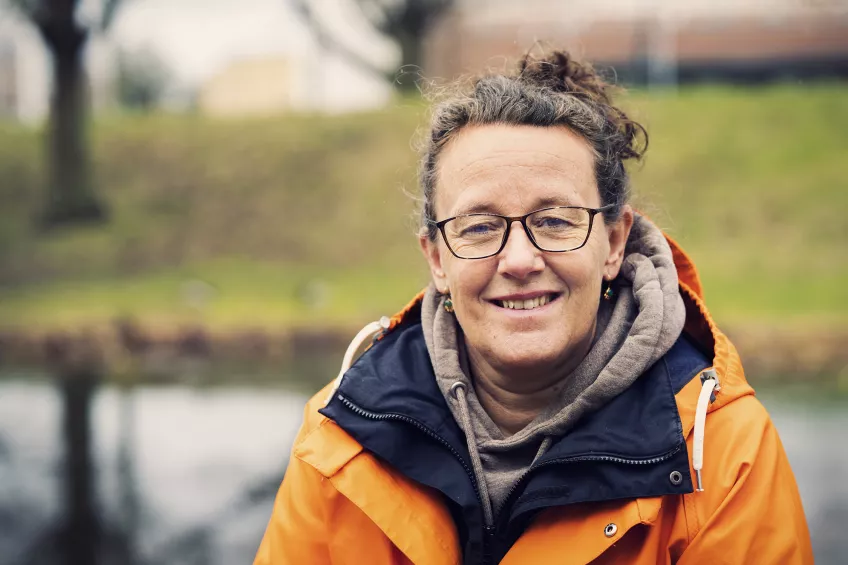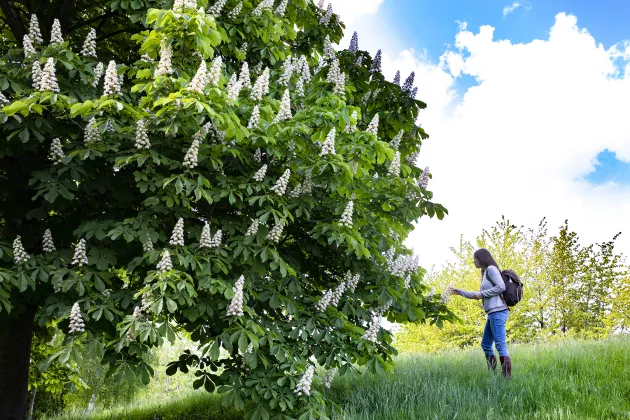Nature as a model for greener cities

Swapping concrete and asphalt for trees, ponds and green roofs is an example of how cities can be adapted to cope with heavy rain and climate change. But time is running out. For nature-based solutions to have a global impact, we need to act fast, according to researchers.
A late summer’s day in August 2014, 100 mm of rain fell over the course of a 24-hour period in the Sofielund area in Malmö. Basements flooded and stormwater streamed out of sewers. Those who owned a pump of their own counted themselves lucky. Within hours, there were no more pumps to be found in the shops of Malmö.
“The amount of cloudbursts is expected to increase with global climate change. This places new demands on cities to be able to manage large volumes of rain without damage to people, buildings and infrastructure,” says Johanna Alkan Olsson from the Centre for Environmental and Climate Science, Lund University in Sweden.
The world in 2023 is facing several concurrent, and partly contradictory, crises: the climate is warming, species and ecosystems are under threat. At the same time, humans need access to nature and its resources, for recreation and health. What if we could use nature’s own solutions in order to bridge some of the problems and solve many of the challenges we are facing, all at the same time? This is exactly what researchers at Lund University are working on, on a global scale, at the landscape level and in urban environments.
“Simply put, nature-based solutions involve using nature’s own methods to solve social problems. Properly designed, these solutions can benefit biodiversity, mitigate climate change and promote the well-being of humans,” says Johanna Alkan Olsson.
Concrete leads to floods
The events in 2014 made clear that Sofielund’s piped water and sewage systems were not dimensioned to deal with large volumes of rainfall. Hardscaped surfaces which historically have been characteristic of urban environments, that is areas covered by concrete, tarmac and pavers, contributed to the problem.
“Concrete and asphalt absorb heat while also preventing water from penetrating the soil, which results in flooding. Meanwhile, our sewage systems were built a long time ago when the population was less dense, there were fewer hardscaped surfaces and extreme weather events were rarer,” says Johanna Alkan Olsson.
“But how do we build cities in which future rainfall does not cause problems? In another Malmö district, Augustenborg, just a stone’s throw from Sofielund, they have deployed a whole host of nature-based solutions. These include not digging down pipes to lead water away, and instead opting to make use of it – this precious water is used for above-ground “blue-green” solutions. Ponds, rain beds and bowl-shaped beds of grass are visible everywhere. There are many trees, green walls and even a botanical garden on the roof of a multistory carpark. Some roofs are covered in grass instead of traditional roof tiles or metal sheets.
“These are all good examples of how to use nature-based solutions in a city. The rainwater is led to a stream that then waters the trees and supports plant life. The opposite approach is funnelling water from roofs through guttering and downpipes into the ground under wells where underground pipes lead it away from the city. The aim is to keep water locally in the urban environment and therefore enable the conditions for trees and plants to grow and for people to enjoy them,” says Johanna Alkan Olsson.
On the highest political agenda
Nature-based solutions to climate change and the loss of biodiversity were particularly highlighted in 2022, especially during the UN Climate Conference (COP27) and the UN’s Biodiversity Conference (COP15). According to the Swedish Environmental Protection Agency’s report “Nature-based solutions – a tool for climate adaptation and other societal challenges”, studies show that nature-based solutions have the potential to account for 30 per cent of the cost-effective reduction in emissions required before 2030 in order to keep the increase of the global average temperature under 2 degrees.
“We’re not just talking about nature-based solutions in cities, but land stewardship in a broader sense. Nature-based solutions cover urban, agricultural and forest environments,” says Henrik Smith, professor at the Centre for Environmental and Climate Science (CEC) and coordinator for Lund University’s Nature-based Future Solutions profile area.
The protection and restoration of mangrove swamps is an example of a nature-based solution that reduces the amount of greenhouse gases in the atmosphere and contributes to increased biodiversity. The rehabilitation of wetlands is a topic widely discussed and researched, not least in Sweden. The many dried wetland areas release large quantities of carbon dioxide which was previously stored in plant material collected in wetlands.
“Nature-based solutions are the most important tool we have”
In the agreement reached between the world’s nations at COP15, nature-based solutions are described as a method for restoring, preserving and encouraging the contribution nature makes to humanity, and as a means for minimising the effects of climate change.
“The world is facing a double crisis – a changing climate and the accelerating loss of biodiversity. These two crises are tightly linked and affect each other. We can’t solve the climate crisis without dealing with the loss of biodiversity and we can’t stop that without addressing the climate crisis. Nature-based solutions are one of the most important tools we have in order to deal with this bisectional challenge,” says Henrik Smith.
What do you hope research can contribute to the field of nature-based solutions?
“The issue of our climate is extremely acute, and it is exactly these types of interdisciplinary solutions that are needed if we are going to succeed. What characterises our research is that we are working in a nexus, at the cross-section between ecological processes, climate processes and social processes. Within the area of research into nature-based solutions, we are trying to solve many problems simultaneously, instead of – as was the case previously – solving the climate problem alone. It is a great advantage that Lund University has chosen this as a profile area as it means we can work long-term and across subject boundaries. This is crucial if we are to find a solution.”
What happens if we do not take nature-based solutions onboard now?
“Biodiversity loss is irreversible, and the costs will increase dramatically, both for humans and the environment, if we don’t reach these environmental goals quickly. We can mitigate these crises at a much lower cost now than if we wait. If we wait too long, we may be too late,” says Henrik Smith.
Using nature-based solutions
In the forest landscape, older forests can be protected to maintain existing ecosystem services while protecting and enhancing biodiversity. Mixed forests can be promoted to improve their resistance to pests and storms, which are expected to increase because of climate change.
Non-timber forestry can be used to reduce downstream flooding, which is also becoming more common as global temperatures rise.
Restored wetlands can store water while boosting biodiversity. However, they may be particularly vulnerable in a changing climate.
In agricultural landscapes, crop diversity can ensure harvests in times of intense drought or heavy rainfall.
No-till farming slows the flow of water through the landscape; the creation of shaded groves and vegetation adjacent to agriculture can reduce damage from wind and other factors, and provide shade for livestock at high temperatures.
In coastal areas, dune systems can protect against erosion and flooding. Coastal vegetation can bind sand, preventing it from eroding.
Contact information
Johanna Alkan Olsson
Researcher
Mobile: +46 727 41 79 90
Phone: +46 46 222 17 93
johanna [dot] alkan_olsson [at] cec [dot] lu [dot] se (johanna[dot]alkan_olsson[at]cec[dot]lu[dot]se)
Johanna Alkan Olson – LU Research Portal
Henrik Smith
Professor in Zooecology
Mobile: +46 709 78 20 56
Phone: +46 46 222 93 79
henrik [dot] smith [at] biol [dot] lu [dot] se (henrik[dot]smith[at]biol[dot]lu[dot]se)
Profile area at LU
Nature-based future solutions is one of five profile areas at Lund University. The area's unique research aims to improve people's lives and solve global problems.
Other research news
-
11 Dec 2025
New technology reveals migratory birds’ stunning precision in flight
Red-backed shrikes fly thousands of kilometres to reach Africa – and they do so with astonishing precision. Aided by new technology, researchers at Lund University in Sweden have b... -
10 Dec 2025
Fingerprint of ancient seafarer found on Scandinavia’s oldest plank boat
A fingerprint has been found in the tars used to build the oldest known wooden plank boat in Scandinavia, which provides a direct link to the seaborne raiders who used the boat ove... -
10 Dec 2025
Honeybees crowd out bumblebees - even on flower-rich heathlands
When the late summer sun falls over Ireland’s Wicklow Mountains, the slopes turn purple with blooming heather. Honeybees are moved to the heathlands for the sought-after heather ho...



